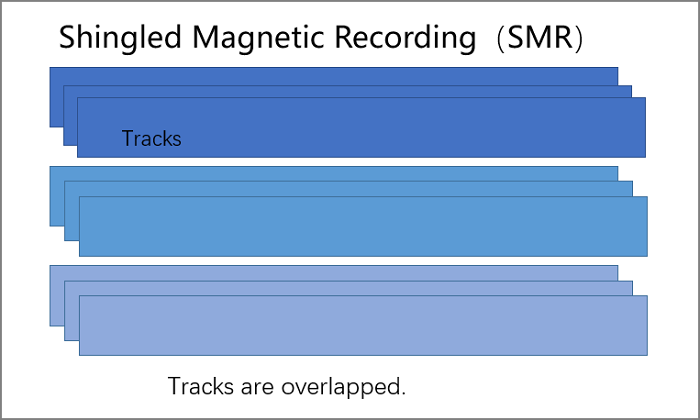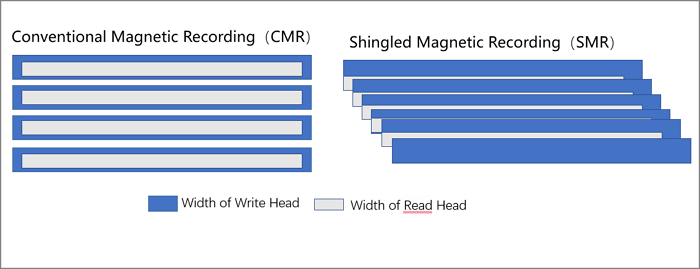CMR vs. SMR Hard Drive: Which One is Better to be Choosen?
Hard drives are essential for data preservation, but choosing the right one can be confusing. A key consideration is the difference between CMR (Conventional Magnetic Recording) and SMR (Shingled Magnetic Recording) hard drives. CMR hard drives store data in a traditional manner, while SMR hard drives store data in a more efficient, overlapping manner, increasing storage density but potentially reducing performance and reliability. The choice between CMR and SMR ultimately depends on individual needs and priorities.
Part 1: CMR vs. SMR vs. PMR Hard Drive: Definition
PMR, SMR, and CMR are three data recording methods for hard disk drives (HDDs). PMR (Perpendicular Magnetic Recording) was the first, but as data storage needs evolved, SMR (Shingled Magnetic Recording) was developed. SMR is actually a subset of PMR, which also includes CMR (Conventional Magnetic Recording).
What is CMR?

Conventional Magnetic Recording (CMR) refers to the method used by traditional hard drives to store data. In this process, data is stored in parallel "tracks" on the hard drive, with a small gap between each track. The arrangement of these tracks determines the storage capacity of the hard drive, as different ordering of tracks can result in varying amounts of available space.
What is SMR?

Shingled Magnetic Recording (SMR) is a technique for recording data that works similarly to shingles. Unlike traditional hard drives, which leave small gaps between tracks, SMR allows data to overlap slightly, increasing the density of the disk and making more space available. This technique is different from Conventional Magnetic Recording (CMR), which leaves a small gap between stored data. By overlapping data, SMR hard drives can store more information on the same amount of space, making them more efficient.
What is PMR?
The terms PMR and CMR are often used interchangeably, with CMR being mentioned more frequently. However, for the purpose of this comparison, I'll focus on CMR (Conventional Magnetic Recording) vs. SMR (Shingled Magnetic Recording).
Part 2: CMR vs. SMR Hard Drive: What are their Differences
Now that we've defined CMR and SMR, let's dive deeper into their specifics. CMR, or Committed Memory Resident, refers to the memory allocated to a process that is guaranteed to be available to it, even if the process is swapped out. This is in contrast to SMR, or Shared Memory Region, which is a shared memory space between multiple processes.

Working Method:
In contrast to SMR (Shingled Magnetic Recording) hard drives, CMR (Conventional Magnetic Recording) drives have parallel tracks, making data operations simpler. SMR drives, on the other hand, have overlapping tracks, requiring a more complex process to write data, involving backing up and erasing existing data before storing new information. This complexity is due to the wider write head compared to the read head, making CMR drives more straightforward to operate.
Capacity
The main difference between CMR and SMR hard drives lies in their capacity. SMR drives have a 25% increase in density, making them larger in capacity, typically above 1TB for 3.5-inch drives or 500GB for 2.5-inch drives. In contrast, CMR drives usually have capacities below 500GB. This difference in capacity is due to the way tracks are arranged, with SMR drives having an additional layer to overlap and increase storage, while CMR drives have less utilized tracks, resulting in smaller capacities.
Speed
The space is more crowded in SMR, making it slower to write data, taking 20ms compared to CMR's 15ms. However, the closer track spacing in SMR allows for slightly faster reading speeds. In contrast, CMR's gaps between tracks make it easier and faster to write data.
Lifespan
The switch to SMR hard drives changed how tracks are distributed, increasing capacity but also putting more stress on the disks. This leads to accelerated aging of the head, especially when frequently erased and written. In contrast, CMR hard drives have independent tracks, so erasing data doesn't affect other information, making it easier to write new data. As a result, CMR hard drives can be used for longer periods compared to SMR hard drives.
Part 3: CMR vs. SMR Hard Drive: Which One to Choose
Comparing the pros and cons of CMR and SMR in the same capacity, we can see that both have their advantages. CMR offers better performance and faster loading times, making it a great choice for gaming and other resource-intensive applications. On the other hand, SMR provides better power efficiency and lower noise levels, making it a more environmentally friendly option. However, SMR's performance may be compromised compared to CMR, and it may not be suitable for applications that require high performance. Ultimately, the choice between CMR and SMR depends on your specific needs and priorities.
Comparison:
| Comparison | CMR | SMR |
|---|---|---|
| Price | Expensive | Cheaper |
| Speed | Quicker | Slower |
| Flexibility | More flexible | Less flexible |
| Security | It's simple to use and won't interfere with other data. | Low: other data will be affected |
Choice
SMR and CMR hard drives have their own advantages. SMR drives offer more capacity at a lower price, making them suitable for archiving static data. On the other hand, CMR drives prioritize speed, flexibility, and security, making them a better choice for daily work. It's a smart decision to opt for CMR hard drives for most needs.
CMR HDD List:
| BRAND | MODEL | CAPACITY | PRICE |
|---|---|---|---|
| Seagate | Ironwolf | 4TB | $125.98 |
| WD | Red Plus | 4TB | $109.98 |
| WD | MyBook | 8TB | $239.96 |
| WD | Red Plus | 2TB | $59.98 |
| WD | White | 14TB | $329.94 |
Part 4: CMR VS SMR Gaming: Which is More Suitable?
CMR hard drives are more suitable for gaming due to their faster operations, which help with frequent game updates. Using an SMR hard drive for gaming may lead to performance issues, game freezing, or system bugs, making it essential to have a disk backup to prevent data loss in case of unexpected system crashes.
Part 5: CMR VS SMR for NAS: Which is Better?
NAS is primarily used for sharing and learning in homes and businesses, storing data. When choosing a hard drive for NAS, a key consideration is the type of drive to use - CMR (Conventional Magnetic Recording) or SMR (Shingled Magnetic Recording). While CMR drives are expensive, they offer better performance. On the other hand, SMR drives are more affordable and have sufficient capacity, but may compromise on performance due to the way data is recorded. Ultimately, the choice between CMR and SMR drives depends on balancing capacity needs with performance requirements.
CMR hard drives are suitable for storing home or work data, which are typically operational data that need to be written frequently. This type of data is essential and requires safe and quick addition, making CMR a good choice for NAS storage.
Conclusion
CMR and SMR hard drives are both suitable for data storage, but they serve different purposes. CMR hard drives are ideal for active data, such as gaming or NAS, while SMR hard drives are better suited for static data, like video and audio storage, or data archiving. When choosing a hard drive, consider your specific needs and compare the features of different options to make an informed decision.
Related Articles
- Full Backup vs. Incremental Backup: Definition, Pros and Cons
- What Is RSAT? How to Install Remote Server Administration Tool on Windows? [All You Should Know]
- How to Customize Lock Screen on Windows 10
- What Is Schedule Backup? How to Set to Protect Your Data?